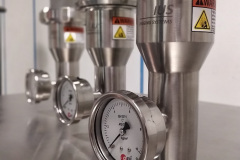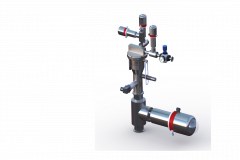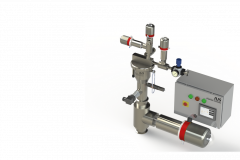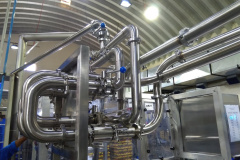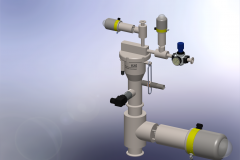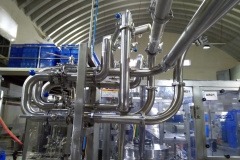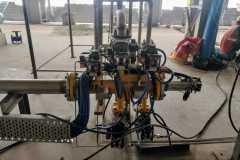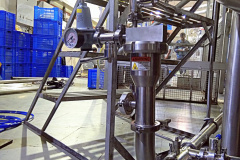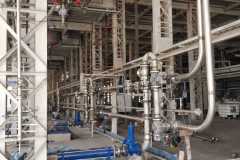Product Recovery System (Pigging)

Product Recovery System (Pigging)
Product recovery systems (PRS), or pigging systems, are designed to recover valuable product that would otherwise be lost to waste.
Pigging, as a manufacturing process, is where a pig is sent down a piping system to clean the pipe and/or recover product in the line. This process is used in many food and beverage, cosmetics, and pharmaceutical application for the same reasons.
Applications:
Hygienic Pigging System: Dairy / Beverage / Food Industries.
Industrial Pigging System: Oil Industries / Cosmetics Industries / Tooth Paste Industries / Paint And many more…
Product List
PIGGING
MAIN ADVANTAGES OF USING A PIGGING SYSTEM
- To recover product at the end of a production run.
- Less down time & quick change over.
- To reduce Clean In Place (CIP) costs.
- No hazardous chemicals involved.
- Product recovery is in the high 99 percentile
- Pig are designed to go through 3D radius bends
- Pig remains in the system at all times while allowing “full product flow”, it can be cleaned in place at 90oC/ 194oF and/or sterilized at 140oC/284oF for over an hour.
- Unique launcher design allows easy removal of pig for maintenance, all other components are also easily serviceable
- Manual and automated options allow product management as well as integration into general plant management operations.
- High return on investment because of full product protection / recovery, ease of CIP, speed of product changeover.
The pig, described by as a metal bullet with rubber flanges, pushes out the viscous Coatings.
Applications of:
A. Hygienic Pigging System: Dairy / Beverage / Food Industries
- Chocolate Syrup used in Chocolate plants
- Ice cream plants : At the end of each flavour run, the ice cream processor pigs the line so that the previous flavour (vanilla, for example) does not contaminate the next flavour (dark chocolate).or Coatings on novelties.
- Hot Cheese in pipe line transfer form gets accumulated in the pipeline after the cycle which can be recovered from the Pipeline and collected , may be at packing Junction and pipes can be cleaned with the same pigging system.
- Viscous coatings used for Ice creams. And many other dairy products can be recovered from the pipeline. The coatings are captured and can be reused in a later production run.
B. Industrial Pigging System:
Oil Industries / Cosmetics Industries / Tooth Paste Industries / Paint and many more industries
Pigs are used in the oil and gas business to retrieve high-value products in the process line as well as to clean the line build-up. The projectile (pig/pusher) generated a squealing noise as it sped through the pipeline, therefore the name “pig”.
Costs benefits and Operational Details of Pigging
Dairy processors looking to install a pigging system must consider the costs and benefits. The more valuable the product, the quicker the return on investment will be, The best areas in a dairy plant for product recovery are those with long product runs, such as from a finished product tank to a filler bowl.
Pigging is a vital process most beneficial to manufacturers of high viscous and expensive liquids. It is most advisable for processes which have numerous changeovers long process pipelines resulting in contamination or non recoverable product.
A pig (projectile) will clear around 99% of the product from its launching point to receiving point. This means there will also be benefits when cleaning the line. A processor will have less waste to dispose of and possibly less cleaning time.
In a pigging system, Pig corresponding to the inside diameter of the tube is pushed through piping with compressed air or a cleaning agent. Nitrogen, CO2, and water can be used. Sometimes air and water are used in tandem.
The pigging process results in the pipes being almost completely emptied, Systems can be retrofitted into existing dairy plants. If the PRS is to be installed in an existing facility, the current tube conditions must be inspected and verified to be suitable for pigging or adjusted accordingly. If the PRS will be installed in a new facility, then the tubing can be installed to the required specifications to ensure the highest efficiency.
A pigging system does require a consistent inside diameter without obstructions or projections (such as instrumentation or valves). Although pigging around elbows is possible and common practice, the number of elbows within the system should be kept to a minimum to increase the life span of the pig, One of the basic prerequisites for friction-free operation is the surface quality of the inner walls, as well as the quality of the welds. Orbital welding is essential for the process of piping and tubing.
The return on investment (ROI) depends on the value and type of product, length of the line, number of push-outs per time period versus the cost of the equipment, and installation.
Pigging systems are a necessity for cost-conscious managers. Pigging systems provide almost total product recovery, allow for a quick product change, reduce the production cost, reduce cleaning cost, and are environmentally friendly
IUS has been supplying and commissioning Pigging System for various industries since 2005. Pigging systems are specially tailored systems to suit our clients differently depending on their production process.
Once Pigging System is designed and incorporated to our customer’s needs, it enables the following:
- Easy Clean ability
- Fully Automated
- Closed Pigging
- Product Recovery
- Multi-Product Transfer
- Quick changeover between different products
- Reduced Contamination
- Low/ In-Expensive maintenance
Different types of Pigging Systems:
Since Pigging Systems are not off the shelf item, it can be tailored to the specific requirement of different customers.
Pigging System are generally categories as:
Single pig system and dual pig system which are available with a optional closed washing system also.
This is generally incorporated into our customer process with:
Either completely manual systems, semi-automated systems or fully automated systems controlled by PLC and supported by either HMI or SCADA system, which is a very effective and precise solution.

